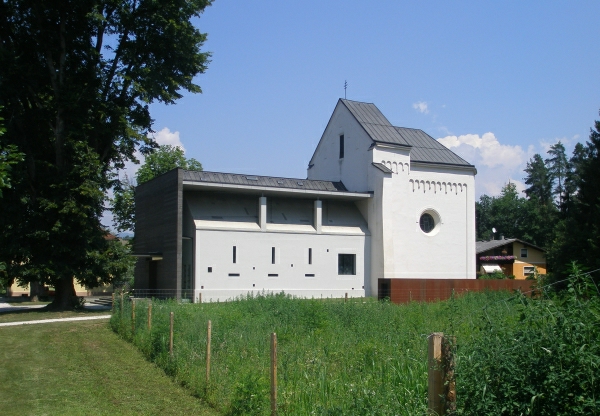Three Contemporary Places of Pilgrimage
The Church of Carpathian Motherland, Verőce
Architects: Endre Szűcs, Péter Tóth
Text: Péter Mújdricza
Photos: András Hadik, Márton Tóth
Farkas Bethlen, the mayor of Verőce decided to have a church – bearing the name the Carpathian Motherland – built from pulic contributions with a wide scale collaboration and in voluntary work along the road to Katalin-puszta near the village in the Danube Bend, on a forested hill in the vicinity of Lósi Valley. Underneath the eaves along a whole ellipse starting at the body of the tower, the row of windows embraces the white plastered brick building with a coloured glass composition as its central component behind the altarpiece/Lord’s table. Pews with elaborated design and execution emphasize the axis of the church with the forms of their lateral wooden parts and oval-shaped ending, resembling either grains of wheat or the canopies of trees. It is a declaredly tale-telling, narrative type of architecture widening and broadening the choking existential experience of consumer „modernism” into cosmic dimensions. The exterior facade of the encircling walls slightly bending inward and the tower are clad in grey slating which „transcends” them towards the clouds and the skies.
Clestial Ark in Magyarföld
Architect: Péter Mújdricza
Text: Lajos Kőszegi
Photos: Zoltán Bánfalvi, Attila Kleb, Péter Mújdricza
The church floating in the deep green arc of forests is visible from afar. Magyarföld, that is the land of Magyars (Hungarians) could only be accessed on foot. There are hardly more than twenty houses in the village. The genius of the landscape in Őrség is fascinatingly beautiful, always changing and withdrawing, protecting and treasuring itself – the lost face of Eden –, and only rceiving anyone at the price of sacrifices.
There is a church towering above the village from now on. It is radiantly simple and open to new vistas. It is not only a symbolic ship, but a genuine ark holding the entire planet on its fragile body, and gracely gliding with its gigantic burden in a sea-blue sky. In-between the sixteen columns above huge windows circle the church. The sixteen wooden columns of the nave are erected in the spirit of number seven, comprising the divine trinity and the human quaternity. Trinity is represented in the coordination of spaces, in the nave and the three masses joining it in an organic way. Larch from the forests of Őrség are the wood forming the body of the church wearing the tracery of the entire universe, a secret map of the Milky Way, with that of navigation apearing vaguely through their bodies.
Autobahnkirche – Dolina, Karinthia
Architects: Ferdinand Čertov, Robert Morianz
Text and photos: György Szegő
In the hectic world of motorization „Autobahnkirche” has turned into a unique sacred architectural function. In Germany it has evolved as a network by now. In Austria the church in Dolina is the first of this kind. Offering acquiescence and the release of tension to believers and travellers alike, it is a place where the soul and the body can relax. This house was a pioneering experiment of regionalist modernism and is regarded as its most fascinating achievement. This function has been enriched by further experimentation, as the church in Dolina bearing the name „Maria im Walde” (Mary of the Forest) is also a virtual cemetery, there is a rusty iron box right next to the building: a monument erected in honor of victims who died in road accidents. The new nave of the church is actually the gable-roofed archetype of the house design above which a ferro-concrete guard-plate awning seems to be floating. The varied identity of the creators and the spirit of the location faithfully reflect regional history as the structure complies with the local believers, pilgrims and profane travellers.
















